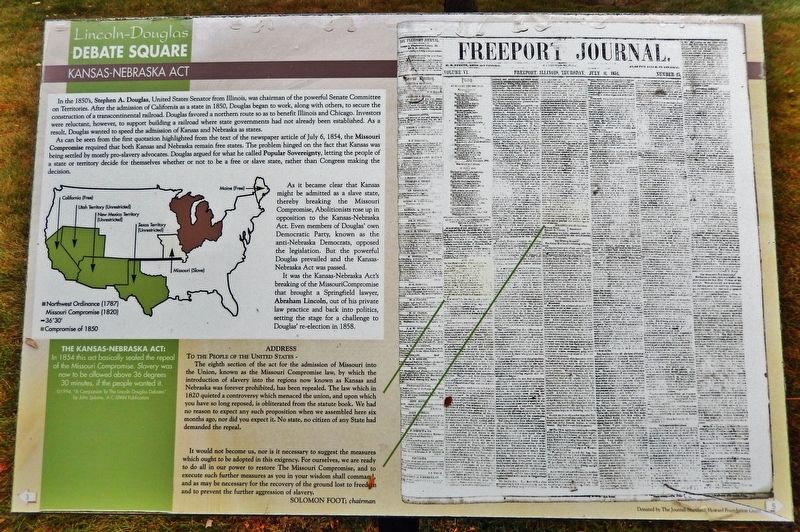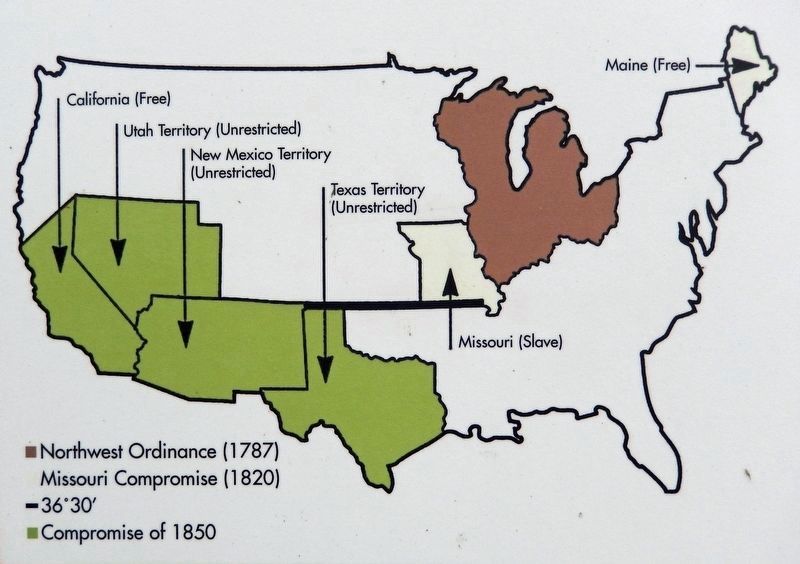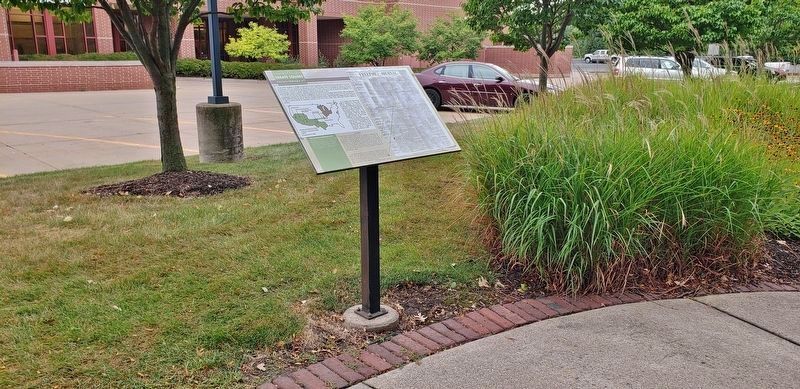Freeport Township in Stephenson County, Illinois — The American Midwest (Great Lakes)
Kansas-Nebraska Act
Lincoln-Douglas Debate Square
In the 1850's, Stephen A. Douglas, United States Senator from Illinois, was chairman of the powerful Senate Committee on Territories. After the admission of California as a state in 1850, Douglas began to work, along with others, to secure the construction of a transcontinental railroad. Douglas favored a northern route so as to benefit Illinois and Chicago. Investors were reluctant, however, to support building a railroad where state governments had not already been established. As a result, Douglas wanted to speed the admission of Kansas and Nebraska as states.
As can be seen from the first quotation highlighted from the text of the newspaper article of July 6, 1854, the Missouri Compromise required that both Kansas and Nebraska remain free states. The problem hinged on the fact that Kansas was being settled by mostly pro-slavery advocates. Douglas argued for what he called Popular Sovereignty, letting the people of a state or territory decide for themselves whether or not to be a free or slave state, rather than Congress making the decision.
As it became clear that Kansas might be admitted as a slave state, thereby breaking the Missouri Compromise, Abolitionists rose up in opposition to the Kansas-Nebraska Act. Even members of Douglas' own Democratic Party, known as the anti-Nebraska Democrats, opposed the legislation. But the powerful Douglas prevailed and the Kansas-Nebraska Act was passed.
It was the Kansas-Nebraska Act's breaking of the Missouri Compromise that brought a Springfield lawyer, Abraham Lincoln, out of his private law practice and back into politics, setting the stage for a challenge to Douglas' re-election in 1858.
The eighth section of the act for the admission of Missouri into the Union, known as the Missouri Compromise law, by which the introduction of slavery into the regions now known as Kansas and Nebraska was forever prohibited, has been repealed. The law which in 1820 quieted a controversy which menaced the union, and upon which you have so long reposed, is obliterated from the statute book. We had no reason to expect any such proposition when we assembled here six months ago, nor did you expect it. No state, no citizen of any State had demanded the repeal.
It would not become us, nor is it necessary to suggest the measures which ought to be adopted in this exigency. For ourselves, we are ready to do all in our power to restore The Missouri Compromise, and to execute such further measures as you in your wisdom shall command, and as may be necessary for the recovery of the ground lost to freedom and to prevent the further aggression
of slavery.
Erected by The Journal-Standard, Howard Education Grant.
Topics and series. This historical marker is listed in these topic lists: Abolition & Underground RR • Government & Politics • Railroads & Streetcars • Settlements & Settlers. In addition, it is included in the Former U.S. Presidents: #16 Abraham Lincoln series list. A significant historical year for this entry is 1854.
Location. 42° 18.033′ N, 89° 37.205′ W. Marker is in Freeport, Illinois, in Stephenson County. It is in Freeport Township. Marker can be reached from the intersection of East Douglas Street (Illinois Route 75) and North State Avenue, on the left when traveling east. The marker is located along the walkway in Lincoln-Douglas Debate Square. Touch for map. Marker is at or near this postal address: 114 East Douglas Street, Freeport IL 61032, United States of America. Touch for directions.
Other nearby markers. At least 8 other markers are within walking distance of this marker. Early Slavery Issues (here, next to this marker); Second Lincoln-Douglas Debate Monument (here, next to this marker); Boulder Dedication (a few steps from this marker); Stephen A. Douglas (a few steps from this marker); Abraham Lincoln (a few steps from this marker); Welcome to Debate Square
(a few steps from this marker); Debates' Structure (a few steps from this marker); The Freeport Lincoln-Douglas Debate (within shouting distance of this marker). Touch for a list and map of all markers in Freeport.
Related markers. Click here for a list of markers that are related to this marker. 2nd Lincoln-Douglas Debate • Freeport, Illinois
Also see . . . Kansas–Nebraska Act (Wikipedia). Excerpt:
The Kansas–Nebraska Act of 1854 was a territorial organic act that created the territories of Kansas and Nebraska. It was drafted by Democratic Senator Stephen A. Douglas, passed by the 33rd United States Congress, and signed into law by President Franklin Pierce. The bill effectively repealed the Missouri Compromise, stoking national tensions over slavery. Douglas and former Illinois Representative Abraham Lincoln aired their disagreement over the Kansas–Nebraska Act in seven public speeches during September and October 1854. Lincoln gave his most comprehensive argument against slavery and the provisions of the act in Peoria, Illinois, on October 16, in the Peoria Speech. He and Douglas both spoke to the large audience, Douglas first and Lincoln in response, two hours later. Lincoln's three-hour speech presented thorough moral, legal, and economic arguments against slavery and raised Lincoln's political profile for the first time. The speeches set the stage for the Lincoln-Douglas debates four years later, when Lincoln sought Douglas's Senate seat.(Submitted on September 24, 2023, by Cosmos Mariner of Cape Canaveral, Florida.)
Credits. This page was last revised on September 27, 2023. It was originally submitted on September 24, 2023, by Cosmos Mariner of Cape Canaveral, Florida. This page has been viewed 57 times since then and 12 times this year. Photos: 1, 2, 3. submitted on September 24, 2023, by Cosmos Mariner of Cape Canaveral, Florida.


